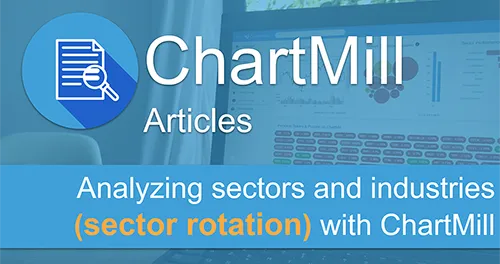Top Strategies for Sector-Based Stock Screening
By Kristoff De Turck - reviewed by Aldwin Keppens
Last update: Sep 17, 2024

Sector-based stock screening is a powerful approach to investing that allows you to focus on specific parts of the economy and identify the best-performing stocks within those sectors. By honing in on particular sectors, you can capitalize on market trends, reduce risk, and align your investments with broader economic cycles. Below are some of the top strategies for sector-based stock screening that can help you optimize your portfolio.
1. Trend Following Within Sectors
Trend following is a strategy that involves investing in stocks that are showing strong upward momentum within a particular sector. This approach is based on the idea that stocks that have been performing well will likely continue to do so, especially when supported by a strong sectoral trend.
Identify Leading Sectors:
Use sector ETFs and market performance data to identify which sectors are currently outperforming the broader market.
Screen for Momentum Stocks:
Once you’ve identified the leading sectors, screen for stocks within those sectors that are trading above their moving averages (e.g., 50-day or 200-day) and have high relative strength (RS).
ChartMill Momentum Trading Ideas
Example Strategy:
Focus on technology stocks during periods of high innovation and digital transformation, or energy stocks during a commodities boom.
Example Screen: Technology Stocks with High Momentum
Why It Works:
By riding the momentum of top-performing sectors, you can maximize returns while aligning your portfolio with prevailing market trends.
2. Value Investing in Specific Sectors
Value investing involves identifying undervalued stocks within a sector that are trading below their intrinsic value. This strategy is particularly effective in sectors that may be temporarily out of favor but are poised for recovery.
Sector Rotation:
Monitor economic cycles to determine which sectors are currently undervalued. For instance, defensive sectors like utilities or consumer staples often become undervalued during economic expansions but may provide value opportunities.
Screen for Undervalued Stocks:
Screen for stocks within these sectors with low Price-to-Earnings (P/E) ratios, high dividend yields, and strong balance sheets (positive cash flow, low debt).
ChartMill Value Investing Trading Ideas
Example Strategy:
Invest in healthcare or industrial stocks during periods of market downturns, when these sectors may be undervalued compared to their long-term growth potential.
Example Screen: undervalued Healthcare & Industrials stocks
Why It Works:
Value investing in specific sectors allows you to buy quality companies at a discount, increasing the potential for significant gains when the sector rebounds.
3. Sector Rotation Strategy
The sector rotation strategy involves shifting investments between sectors based on the different phases of the economic cycle. This strategy helps investors capitalize on sectors that are expected to outperform during specific stages of the economy.
Economic Cycle Analysis:
Understand the different phases of the economic cycle — expansion, peak, contraction, and trough — and how different sectors perform during each phase.
Expansion: Cyclical sectors like technology, consumer discretionary, and industrials tend to outperform.
Contraction: Defensive sectors like utilities, healthcare, and consumer staples tend to be more resilient.
Screen for Sector Leaders:
Use sector-specific stock screeners to identify leading companies within the sectors poised to benefit from the current or upcoming economic phase.
ChartMill Breakout Trading Ideas
Example Strategy:
Rotate into financials and consumer discretionary during economic recoveries and into healthcare and utilities during downturns.
Example Screen: Stocks ready to breakout in Financials & Consumer Discretionary Sector
Why It Works:
Sector rotation allows you to align your portfolio with the economic cycle, potentially improving returns while reducing risk by focusing on sectors with the best prospects at any given time.
4. Dividend Growth Strategy by Sector
This strategy focuses on identifying sectors and companies that offer consistent dividend growth. It’s particularly appealing to income-focused investors who seek both capital appreciation and steady income streams.
Identify Dividend-Paying Sectors:
Sectors like utilities, consumer staples, and healthcare are known for companies that regularly pay and increase dividends.
Screen for Dividend Growth:
Use stock screeners to find companies within these sectors that have a history of increasing their dividends over time, alongside a strong payout ratio and cash flow.
ChartMill Dividend Growth Trading Ideas
Example Strategy:
Focus on consumer staples and utilities during periods of market volatility for reliable dividend income, or healthcare stocks for a combination of growth and dividends.
Example Screen: Decent Dividend Growth Stocks (Consumer Staples and Utilities)
Why It Works:
Dividend growth investing provides a steady income stream and can offer capital appreciation, especially in sectors known for their financial stability and consistent earnings.
5. Contrarian Sector Investing
Contrarian investing involves taking positions in sectors that are currently out of favor or undervalued by the market, with the expectation that they will rebound over time.
Identify Undervalued Sectors:
Look for sectors that are experiencing temporary setbacks but have strong long-term fundamentals, such as energy during an oil price slump or financials during a banking crisis.
Screen for Strong Companies:
Within these sectors, screen for companies with strong balance sheets, solid cash flows, and a history of resilience during downturns.
ChartMill Quality Investing Trading Ideas
Example Strategy:
Invest in Technology (growth) stocks during times when interest rates are relatively high. As soon as interest rates fall, growth stocks will be the first to benefit.
Example Screen: Terry Smith Quality Stocks (Information Technology)
Why It Works:
Contrarian investing allows you to buy into sectors when they are undervalued, potentially leading to significant gains when the sector recovers.
6. Thematic Investing by Sector
Thematic investing focuses on long-term trends and themes that cut across multiple sectors but may be concentrated in a few. This strategy involves identifying a theme, such as renewable energy or artificial intelligence, and investing in the sectors that are most likely to benefit.
Identify a Theme:
Choose a theme that you believe will drive future growth, such as green energy, aging population, or artificial intelligence.
Screen for Thematic Stocks:
Use sector-based screeners to find companies within relevant sectors (e.g., technology, healthcare, energy) that are well-positioned to benefit from the theme.
ChartMill System Software Stocks (US only)
Example Strategy:
Invest in technology and industrial stocks focused on artificial intelligence and automation or energy stocks involved in renewable energy.
Why It Works:
Thematic investing allows you to capitalize on long-term trends, providing opportunities for substantial growth by focusing on sectors that are at the forefront of transformative changes.
Conclusion: Selecting the Right Strategy for Your Portfolio
The success of sector-based stock screening largely depends on choosing the right strategy that aligns with your investment goals and market outlook.
Whether you’re a momentum investor looking to capitalize on trending sectors, a value investor seeking undervalued opportunities, or a thematic investor focusing on long-term trends, sector-based screening can help you pinpoint the best stocks within your chosen sectors.
By applying these strategies, you can build a well-diversified portfolio that is positioned to outperform in various market conditions.







